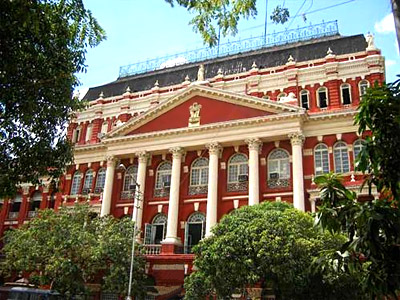 Writers` Building is the foremost secretariat building for the West Bengal state government, located in Kolkata. Seat for the state Chief Minister and other cabinet ministers, Writers` Building exercises total control upon the state and its governance, build as it was during colonial times precisely for this primary reason. History of Writers` Building speaks about Calcutta (Kolkata during those times was pronounced by that name) being elected as the capital city of India, with the Company`s and later Queen`s rule exercising full power from this very majestic brick red structure. The present Writers` Building in Calcutta was first taken up as early as 1690. Within the boundary of the old fort, the junior writers or clerks of the East India Company used to reside in mud shanties. Hence it came to be known by its unique name, the `Writers` Building`. On 25th June, 1695, these shanties were destroyed by a violent and disastrous wind. And then, the second Writers` Building was erected within the old fort. In 1706, the new one-storeyed brick-made edifice was erected. The other Writers` Building stood at the place where the G.P.O. (General Post Office) or Fairly Place stands today.
Writers` Building is the foremost secretariat building for the West Bengal state government, located in Kolkata. Seat for the state Chief Minister and other cabinet ministers, Writers` Building exercises total control upon the state and its governance, build as it was during colonial times precisely for this primary reason. History of Writers` Building speaks about Calcutta (Kolkata during those times was pronounced by that name) being elected as the capital city of India, with the Company`s and later Queen`s rule exercising full power from this very majestic brick red structure. The present Writers` Building in Calcutta was first taken up as early as 1690. Within the boundary of the old fort, the junior writers or clerks of the East India Company used to reside in mud shanties. Hence it came to be known by its unique name, the `Writers` Building`. On 25th June, 1695, these shanties were destroyed by a violent and disastrous wind. And then, the second Writers` Building was erected within the old fort. In 1706, the new one-storeyed brick-made edifice was erected. The other Writers` Building stood at the place where the G.P.O. (General Post Office) or Fairly Place stands today.
According to annals regarding history of Writers` Building, the unfilled land for the remaining structure was then handed over by the collector of Calcutta to Thomas Lyon. The remaining edifice was essential to construct residential places for the writers of the East India Company. The preliminary works of the present-day Writers` Building or `Mahakaran` (as it is popular in Bengali) was wrapped up in 1780. Later, Barwell, a friend of Warren Hastings and a member of the Committee, was named the owner of the house. Barwell`s children handed it over to a trustee board, which in turn was again leased to the East India Company. The Britons started to utilise Writers` Building for private affairs and for merry-making and enjoyment. Hence the Company started out to enforce several limitations upon them, which as a consequent outcome, made the house vacant. The Fort William College was in fact founded here in 1800. History of Writers` Building also states that the College was transferred from there in 1830. In 1836, Lord William Bentinck banned the haphazard use of the building for classified issues. Within the period of 1877 to 1882, Lt. Governor Ashley Eden installed the keystone of the Government Department at this place, paving way for legendary red-tape affairs still being governed methodically. The current colossal building encompasses 2.8 acres of land. Writers` Building measures 235 yards in breadth. A bunch of thirteen four-storeyed buildings, the `Mahakaran` holds firm ground on 10 acres of land. Approximately six thousand employees are employed here at present. The ministers have their official departments allocated in this house.
There exists a record office in the `Mahakaran` which maintains every sort of records and significant documents of the Government of West Bengal since 1834. The Writers` Building presents an archetypal instance of Gothic architecture. History of Writers` Building represents its erstwhile memories, analyzing that there stands an iron pillar over the primary entrance. In earlier times, a figurine of Britannia was put up in this place. Four symbolic idols can be witnessed on top of the floor personifying science, cultivation, commerce and justice.



















